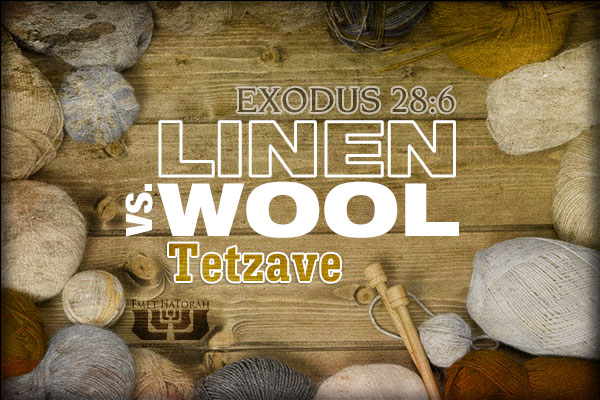Parashat Tetzave - Exodus 27:20-30:10
Series:

After giving instructions for making the oil for the Temple menorah, parashat Tetzave is primarily focused on the consecration of the kohanim (priests). This consecration includes how the priestly garments, particularly those of the Kohen Gadol (high priest), are to be tailored. The garments of the Kohan Gadol were to be unique in every way. One garment in particular, the ephod, was to be made of a special combination of various materials:
And they shall make the ephod of gold, of blue and purple and scarlet yarns, and of fine twined linen, skillfully worked. (Exodus 28:6)
These components—gold (thread), blue (yarn), purple (yarn), scarlet yarn, and fine linen—were all to be woven together by an expert craftsman to create something beautiful and unique for the man who would serve in the most holy position on earth. Since the gold was to be used as in the fabric itself, creating this gold thread would have been a challenging endeavor. The blue, purple, and scarlet yarn would have been made from the wool of sheep or goats that had been dyed to a rich and vibrant color. The linen (made from the fibers of flax stalks), however, would have been either left in its natural color or bleached to appear a pure white. Once all of these materials were woven together, the ephod would have taken on a color, texture, and pattern that would set the Kohen Gadol apart from all of the other kohanim (priests) designated to serve Hashem.
A problem arises, however, when we get to a prohibition recorded for us in Deuteronomy. It says, “You shall not wear cloth of wool and linen mixed together” (Deuteronomy 22:11). According to the Torah, wool and linen are not permitted to be woven together. So how does this apply to the garments of the Kohen Gadol? In situations like this, we apply the principle in the Talmud taught to us by Reish Lakish: “Any place where you find a positive mitzva and a prohibition that clash with one another, if you can find some way to fulfill both, that is preferable; and if that is not possible, the positive mitzva will come and override the prohibition” (b.Nazir 41a). Therefore, the positive commandment to blend the fibers to create the ephod for the Kohen Gadol overrides the general prohibition of not mixing wool and linen together.
Why then does the Torah prohibit the mixture of wool and linen to begin with? Is there a chemical or physical reaction that takes place between the wool and the linen? Possibly, but that is not likely the reason for this prohibition. Most likely this prohibition involves boundaries of distinction between the Kohen Gadol and everyone else. Hashem has designated him as the most holy man on the face of the earth. But if the common Israelite, or even the other kohanim are able to wear garments that are similar or the same as his, then his holiness—his set-apartness— is diminished. This is also why the Torah prohibits the replication of the incense that is to be used in the Tent of Meeting. To replicate it and use it for purposes outside of the context of the holy service is to profane it and make it common.
Many times we innocently attempt to replicate what we see in the beauty of something that was intended to be holy and distinct. However, as we have noted, when lines of distinction are blurred, holiness is lost. In order for something to remain holy, it cannot become common. Peter applied this principle to living a life that is holy:
As obedient children, do not be conformed to the passions of your former ignorance, but as he who called you is holy, you also be holy in all your conduct, since it is written, “You shall be holy, for I am holy.” (1 Peter 1:14–16)
When we try to bring holiness down to our level, then holiness is lost. But it is also lost when we don’t live up to the level of holiness that is expected of us. Holiness is being unique and set apart. Disciples of Yeshua should reflect the appropriate measure of holiness in our lives.








